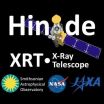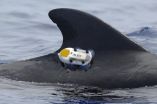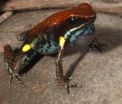(Press-News.org) MOUNT WILSON, Calif.–Astronomers at Georgia State University's Center for High Angular Resolution Astronomy (CHARA) have observed the expanding thermonuclear fireball from a nova that erupted last year in the constellation Delphinus with unprecedented clarity.
The observations produced the first images of a nova during the early fireball stage and revealed how the structure of the ejected material evolves as the gas expands and cools. It appears the expansion is more complicated than simple models previously predicted, scientists said. The results of these observations, carried out by 37 researchers from 17 institutions and led by Georgia State astronomer Gail Schaefer, are published in the current issue of Nature.
On Aug. 14, 2013, the Japanese amateur astronomer Koichi Itagaki discovered a "new" star that was subsequently named Nova Delphinus 2013. A nova occurs following the buildup of a thin layer of hydrogen on the surface of a white dwarf, a highly evolved star with the diameter of the Earth and the mass of the sun. The hydrogen is provided by a close companion, which is a normal star in a binary star system, where the two stars orbit about their center of mass. When this hydrogen "ocean" is perhaps 200 meters (about 650 feet), the enormous surface gravity of the white dwarf produces pressures at the bottom of the hydrogen layer sufficient to trigger thermonuclear fusion, essentially a stellar H-bomb.
The light from the explosion will significantly exceed the star's normal brightness and the object may suddenly appear to the naked eye in a location not previously noted to have a bright star. Over ensuing weeks, the star slowly fades as the fireball expands, cools and dissipates.
Within 15 hours of the discovery of Nova Del 2013 and within 24 hours of the actual explosion, astronomers pointed the telescopes of the CHARA Array toward the nova to image the fireball and measure its size and shape. The size of Nova Del 2013 was measured on 27 nights over the course of two months. The first measurement represents the earliest size yet obtained for a nova event.
The CHARA facility is on the grounds of historic Mount Wilson Observatory in the San Gabriel Mountains of Southern California and is operated by Georgia State. The CHARA Array uses the principles of optical interferometry to combine the light from six telescopes to create images with very high resolution, equivalent to a telescope with a diameter of more than 300 meters. This makes it capable of seeing details far smaller in angular extent than traditional telescopes on the ground or in space. It has the power to resolve an object the size of a U.S nickel on top of the Eiffel tower in Paris from the distance of Los Angeles, Calif.
Measuring the expansion of the nova allowed the researchers to determine that Nova Del 2013 is at a distance of 14,800 light years from the sun. This means that, while the explosion was witnessed here on Earth last August, it actually took place nearly 15,000 years ago.
During the first CHARA observation, the physical size of the fireball was roughly the size of the Earth's orbit. When last measured 43 days after the detonation, it had expanded nearly 20-fold, at a velocity of more than 600 kilometers per second, to nearly the size of Neptune's orbit, the outermost planet in our solar system.
Images of the fireball were created from the interferometric measurements using the University of Michigan Infrared Beam Combiner (MIRC), an instrument that combines all six telescopes of the CHARA Array simultaneously to create images. The observations reveal the explosion was not precisely spherical and the fireball had a slightly elliptical shape. This provides clues to understanding how material is ejected from the surface of the white dwarf during the explosion.
The CHARA observations also showed the outer layers became more diffuse and transparent as the fireball expanded. After about 30 days the researchers saw evidence for a brightening in the cooler, outer layers, potentially caused by the formation of dust grains that emit light at infrared wavelengths.
Thousands of novae have been discovered since the first one was recorded in 1670, but it has only become possible in the last decade or so to image the earliest stages of the explosion thanks to the high resolution achieved through interferometry. Studying how the structure of novae changes at the earliest stages brings new insights to theoretical models of novae eruptions.
INFORMATION:
The CHARA Array is operated by funding from the National Science Foundation and Georgia State's College of Arts and Sciences.
Links
Animation of Fireball expansion: http://www.chara.gsu.edu/NovaDelMovie.gif
CHARA Array: http://www.chara.gsu.edu
Michigan Infrared Combiner (MIRC) – http://dept.astro.lsa.umich.edu/~monnier/Research.html
Georgia State University: http://www.gsu.edu
National Science Foundation Division of Astronomical Sciences – http://www.nsf.gov/div/ index.jsp?org=AST
Mount Wilson Observatory: http://www.mtwilson.edu
BOSTON –– Scientists say they have identified in about 20 percent of colorectal and endometrial cancers a genetic mutation that had been overlooked in recent large, comprehensive gene searches. With this discovery, the altered gene, called RNF43, now ranks as one of the most common mutations in the two cancer types.
Reporting in the October 26, 2014 edition of Nature Genetics, investigators from Dana-Farber Cancer Institute and the Broad Institute of MIT and Harvard said the mutated gene helps control an important cell-signaling pathway, Wnt, that has been ...
Why do we remember some things and not others? In a unique imaging study, two Northwestern University researchers have discovered how neurons in the brain might allow some experiences to be remembered while others are forgotten. It turns out, if you want to remember something about your environment, you better involve your dendrites.
Using a high-resolution, one-of-a-kind microscope, Daniel A. Dombeck and Mark E. J. Sheffield peered into the brain of a living animal and saw exactly what was happening in individual neurons called place cells as the animal navigated a virtual ...
Digoxin, a medication used in the treatment of heart failure, may be adaptable for the treatment of amyotrophic lateral sclerosis (ALS), a progressive, paralyzing disease, suggests new research at Washington University School of Medicine in St. Louis.
ALS, also known as Lou Gehrig's disease, destroys the nerve cells that control muscles. This leads to loss of mobility, difficulty breathing and swallowing and eventually death. Riluzole, the sole medication approved to treat the disease, has only marginal benefits in patients.
But in a new study conducted in cell cultures ...
CHAMPAIGN, Ill. — Researchers report in the journal Nature that they have made a breakthrough in understanding how a powerful antibiotic agent is made in nature. Their discovery solves a decades-old mystery, and opens up new avenues of research into thousands of similar molecules, many of which are likely to be medically useful.
The team focused on a class of compounds that includes dozens with antibiotic properties. The most famous of these is nisin, a natural product in milk that can be synthesized in the lab and is added to foods as a preservative. Nisin has ...
Most of the concerns about climate change have focused on the amount of greenhouse gases that have been released into the atmosphere.
But in a new study published in Science, a group of Rutgers researchers have found that circulation of the ocean plays an equally important role in regulating the earth's climate.
In their study, the researchers say the major cooling of Earth and continental ice build-up in the Northern Hemisphere 2.7 million years ago coincided with a shift in the circulation of the ocean – which pulls in heat and carbon dioxide in the Atlantic ...
DENVER – A better survival outcome is associated with low blood levels of squamous cell carcinoma antigen, or absence of tumor invasion either into the space between the lungs and chest wall or into blood vessels of individuals with a peripheral squamous cell carcinoma, a type of non-small cell lung cancer (NSCLC).
Lung cancer is the most common cause of cancer-related death worldwide and lung squamous cell carcinomas (SCC) account for 20-30% of all NSCLC. SCC can be classified as either central (c-SCC) or peripheral (p-SCC) depending on the primary location. While ...
VIDEO:
On Oct. 23, while North America was witnessing a partial eclipse of the sun, the Hinode spacecraft observed a 'ring of fire' or annular eclipse from its location hundreds of...
Click here for more information.
The moon passed between the Earth and the sun on Thursday, Oct. 23. While avid stargazers in North America looked up to watch the spectacle, the best vantage point was several hundred miles above the North Pole.
The Hinode spacecraft was in the right place at the ...
DURHAM, N.C. -- Many marine animals are world travelers, and scientists who study and track them can rarely predict through which nations' territorial waters their paths will lead.
In a new paper in the journal Marine Policy, Duke University Marine Lab researchers argue that coastal nations along these migratory routes do not have precedent under the law of the sea to require scientists to seek advance permission to remotely track tagged animals in territorial waters.
Requiring scientists to gain advance consent to track these animals' unpredictable movements is impossible, ...
DURHAM, N.C. – Frogs are well-known for being among the loudest amphibians, but new research indicates that the development of this trait followed another: bright coloration. Scientists have found that the telltale colors of some poisonous frog species established them as an unappetizing option for would-be predators before the frogs evolved their elaborate songs. As a result, these initial warning signals allowed different species to diversify their calls over time.
Zoologists at the National Evolutionary Synthesis Center (NESCent), the University of British Columbia, ...
NASA scientists have identified an unexpected high-altitude methane ice cloud on Saturn's moon Titan that is similar to exotic clouds found far above Earth's poles.
This lofty cloud, imaged by NASA's Cassini spacecraft, was part of the winter cap of condensation over Titan's north pole. Now, eight years after spotting this mysterious bit of atmospheric fluff, researchers have determined that it contains methane ice, which produces a much denser cloud than the ethane ice previously identified there.
"The idea that methane clouds could form this high on Titan is completely ...








